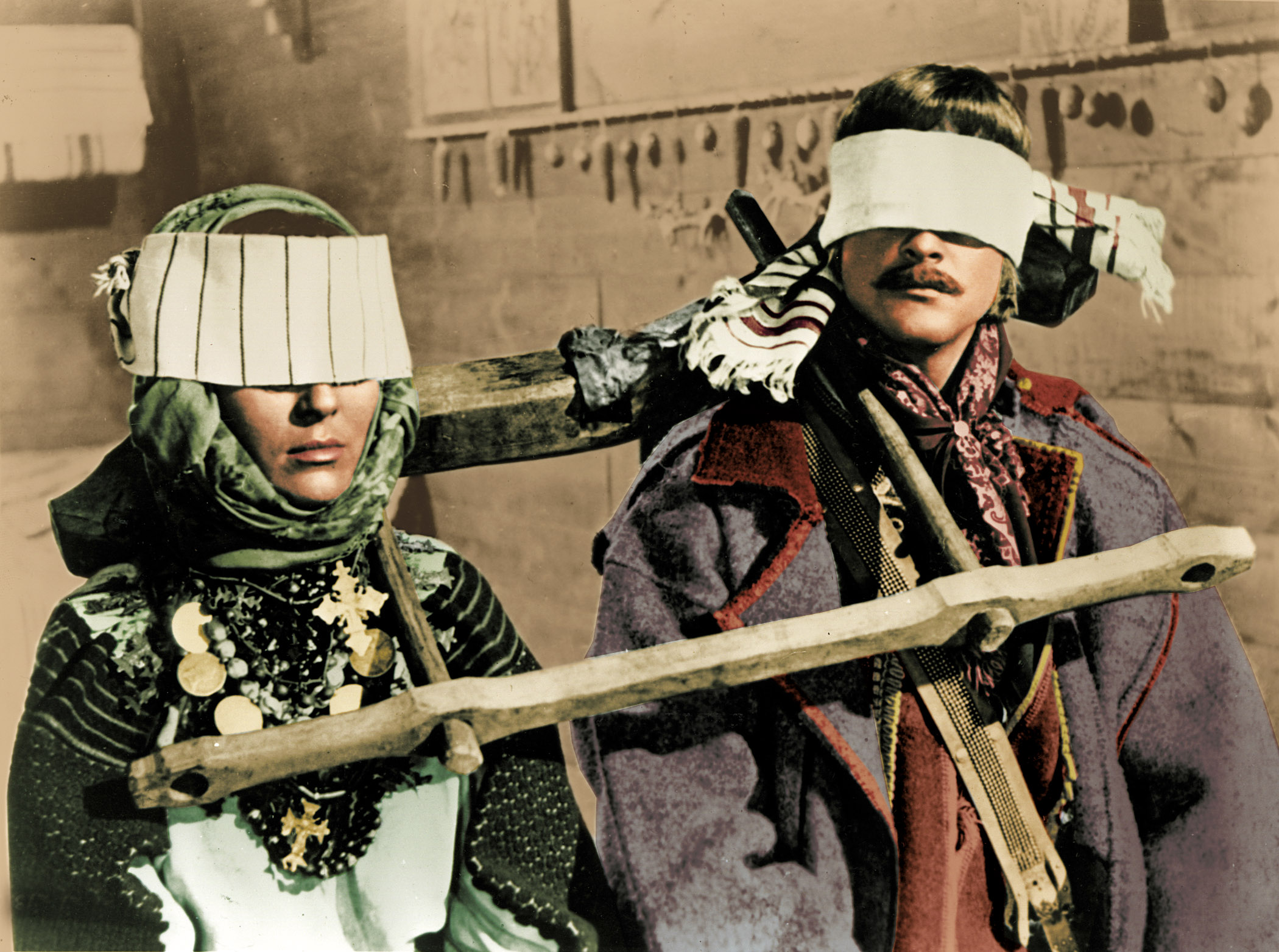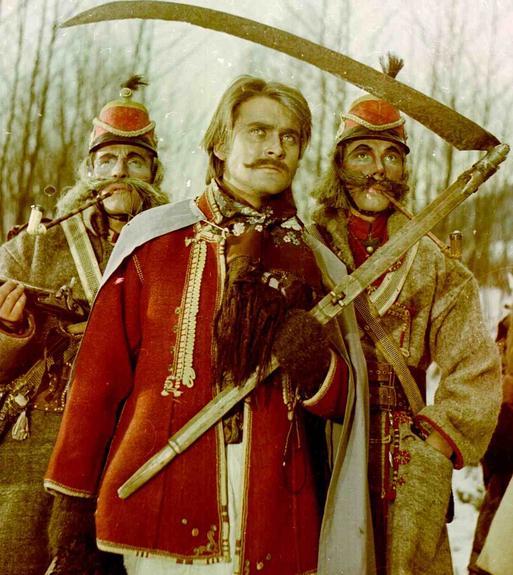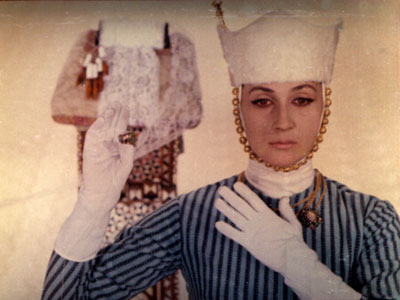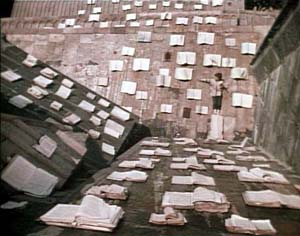Lucidno PARADJANOV
A related economy and simplicity underlies the three features showing at Facets, but significantly the means for achieving this quality shift radically from film to film. Unlike the four other filmmaking geniuses cited by Tarkovsky at the head of this article, as well as Tarkovsky himself, Paradjanov does not display a consistent style matching his persistent vision as he moves from film to film, but a new style to match the requirements of each work. Shadows of Our Forgotten Ancestorslargely achieves stylistic self-definition through dazzling, lyrical, and mainly hand-held camera movements, while The Color of Pomegranates does without camera movement entirely; The Legend of Suram Fortress reintroduces camera movement, but in a completely different manner, restricted to functional pans that are neither hand-held nor rhetorical.
The cultures, myths, landscapes, and languages of the three features are also quite distinct: Ukrainian in Shadows, Armenian (with dashes of Georgian, Persian, and Azerbaijani) in Pomegranates, and Georgian in Suram Fortress. What remains common to all three is an absorption in folklore, magic, dance, and pagan ritual, a nearly continuous use of music, and an unusual relation to temporality that roots these films both in history and in the timeless present. The editing in all three Paradjanov features is often abrupt, and although there’s a world of difference between the narrative ellipses in Shadows and the jump cuts in the other two, the effect in all three is like that of a flat pebble skipping in bright leaps across the placid surface of a lake.
Paradjanov’s relation to narrative is also different in each feature. The episodic, linear plot of Shadows, moving from a doomed love story to a failed and childless marriage, assumes the shape and drift of the hero’s life. While Pomegranates is structured in relation to the life of the poet Sayat Nova, the narrative line is oblique to the point of near-invisibility. The plot of Suram Fortress shifts between several characters, includes a lengthy flashback, covers two generations, and is shaped by the legend of a fortress and its construction rather than the life of any single individual.
Paradjanov’s passionate involvement with his materials is always dialectically joined to a sense of serene detachment. In the precredits sequence of Shadows, we witness the sacrificial death of the hero’s brother Olexa in a snow-covered forest. Pushing the little boy Ivan out of the path of a falling tree, Olexa is crushed underneath it himself. At a crucial moment, Paradjanov cuts to a spectacular view of the event from the top of the falling tree as it plunges to the earth––placing us at the dynamic center of the action, but from the vantage point of impersonal nature rather than that of any human participant. Two deaths converge––a tree’s and a woodsman’s—in the same vertiginous movement, and the effect of this startling camera placement is neither to depersonalize Olexa nor to personalize the tree, but to link the two together in the same harsh destiny.
At Olexa’s funeral, the camera largely assumes Ivan’s viewpoint as it darts quickly from one musician to another and flees from a madman. Soon afterward, Ivan meets Marichka, a little girl his own age. Like Romeo and Juliet they come from feuding families; they fall in love, and go swimming together, naked, in a mountain stream. Then we see them as young adults eating berries together and discussing the possibility of their marriage. Later, Ivan has to leave her to work as a hired hand, and the camera does a 360-degree pan around them before they part in a rainy forest. Just before Ivan returns, Marichka dies while attempting to retrieve a stray lamb from a mountainside; Ivan and the villagers look for her, and her body is finally found in a stream below.
As if to convey the monotone of Ivan’s grief, the film turns from color to sepia while the villagers discuss his depressed state in elliptical snatches offscreen––a mode of narration that recalls the town’s perception of the Minafer family in Welles’s The Magnificent Ambersons. Then color reappears; Ivan meets another woman, Palagna, and before long they are married. When they prove unable to have children, Palagna seeks out a sorcerer and has an adulterous affair with him, which leads to Ivan’s death at the sorcerer’s hands. The last shot shows us eight children looking in through a window at Ivan’s funeral, each one framed by a separate pane.
In order to describe Paradjanov’s singular way of organizing this material, it would help to refer metaphorically to music, architecture, and landscape painting. Adopting music as our ruling metaphor, the narrative of Shadows develops in a manner that might be described as alternations between solos (Ivan and later Palagna), duets (Ivan and Marichka, Ivan and Palagna), and orchestral passages that describe the community’s collective activities and rituals. (The group search for Marichka resembles a plaintive dirge.) If the solos and duets are often lyrical, the orchestral passages are closer to mantras that weave magical spells, and the marriage and Christmas rituals of Ivan and Palagna are remarkable sequences that combine these modes in interwoven tapestries that simultaneously make us aware of individual melodies and collective harmonies.
To mix this metaphor in order to encompass the other two arts, Paradjanov’s employment of architecture and nature to shape and organize his visual compositions effectively turns these elements––the arrangement of a forest or an interior, the pattern of a window or a mountainside––into his musical staff, where his characters are set and grouped like clusters of notes. In fact, this use of indigenous architecture and landscape becomes even more central in his two subsequent features, where it often becomes impossible to separate his settings from his decor and his mise en scene.
The Color of Pomegranates is shot almost exclusively in frontal, hieratically posed tableaux that assume the shallow space of primitive cinema. While all these tableaux appear to have a literal or allegorical relationship to the life and work of Aruthin Sayadin, popularly known as Sayat Nova (the “King of Song”), and are arranged chronologically, the film veers closer to nonnarrative than it does to the continuity and development of a conventional biopic. Indeed, it seems curious that this film should be better known today than either Shadows or Suram Fortress, for it is a good deal more difficult and formally radical, even with the apparent simplifications brought about by Yutkevich’s re-editing.
One useful route into the film is Paradjanov’s own identification with the legendary poet. The opening quotation from Sayadin can indeed be read as the director’s disclaimer: “My water is of a very special kind, / Not everyone can drink it. / My writing is of a very special kind, / Not everyone can read it. / My foundation’s made not of sand, / But of solid granite.” It’s worth noting that, like Paradjanov, Sayadin was born in Tbilisi to very poor Armenian parents, wrote and sang in different languages, and was banned from practicing his art in Georgia near the end of his life.
In other respects, we don’t have to decode the images in any systematic way in order to experience their haunting power. The opening shots show three pomegranates oozing red juice on a white tablecloth, a bloodstained dagger, bare feet crushing grapes, a fish (which promptly becomes three fish) flopping between two pieces of driftwood, and water falling on books, before the poet as a little boy is introduced among these books. (One sequence shortly afterward shows him surrounded by a sea of open books on the roof of an ancient building, their pages riffled by the wind as he looks at pictures in one of them.)
Some critics have related the pomegranates and the dagger to the Turkish massacres of Armenians, but another clue is offered by a quatrain of Sayadin’s poetry in this section––each of the film’s ten sections is introduced by a separate quatrain in a printed title––which the images can be said to gather around:
While the child is growing,
The soul ripens, like fruit,
Through three elements:
Love of books,
Love of God,
Love of songs.
As the film and the poet’s life progress, many of the images become a good deal more complex. In one shot inside a spare white interior, a female figure dressed in red performs an elaborate pantomime with a transparent red cloth over the dummy of an outstretched body; behind her, an empty ornate picture frame suspended from the ceiling swings back and forth; behind that is a rotating statue of a cherub, and, behind that, a motionless and indistinct red painting or fabric. Yet even compositions as intricate as this one register as primitive and childlike–images that giggle with delight rather than brood or ponder, and that often provoke us to do the same.
While it isn’t entirely clear what material was eliminated by Yutkevich, apparently some of it featured female nudity––as did a Paradjanov short, The Frescoes of Kiev, which also encountered censorship. But if the nudity in Shadows is anything to go by, it is a kind of innocent and chaste nudity, closer to the imaginings of an Henri Rousseau than those of a Hieronymus Bosch. Much of this conscious naivete spills over into The Legend of Suram Fortress, although, once again, in a very different context. After films set in the 19th and 18th centuries, this one goes all the way back to the Middle Ages, and medieval art, theater, and literature form much of the basis of the style here. While the frontal shooting style of Pomegranates is partially echoed, a deeper use of space and a much more expansive use of landscape makes the visual style closer to tapestries than to icons. And continuity cutting, which is still used in certain portions of Pomegranates, is eliminated entirely here until the climactic sequence, making each shot an autonomous event.
In a recent interview, Paradjanov claimed that all the props and costumes used in Suram Fortress came from his own house, where he has stockpiled such items for years––a reflection of his low-budget method of shooting that helps explain how he can make his retellings of impersonal myths so personal. (Apparently because he is less fluent in Georgian than he is in Ukrainian, Armenian, and Russian, Paradjanov used one of his lead actors here, Dodo Abashidze, as a codirector because he could communicate better with the other Georgian actors.) One of the major characters, Osman—Agha, whose recounted life story forms a lengthy digression dropped into the middle of the plot, is a Georgian forced to renounce Christianity as a young man and become a Muslim, and in many respects the film’s plot as a whole deals with an encounter between East and West that makes the eventual construction of the fortress––finally effected by a human sacrifice— possible.
If Paradjanov’s films belong to any international film genre, this might be termed the ethnographic-ecstatic, a genre in which ritual plays an important role, magic is taken seriously, and national or regional folk myth is the major source of inspiration. Other recent films in this genre would include Tian Zhuangzhuang’s The Horse Thief from the People’s Republic of China and Souleymane Cissé’s Brightness from Mali (an extraordinary fantasy about the ancient Bambara culture due to open in the U.S. within the next few months); some of the period films of Jancso (Hungarian) and Pasolini (Italian) might be said to represent impure or partial examples.
Curiously, the cultural trappings of Paradjanov’s films may seem even more remote to us than those of The Horse Thief (Tibetan Buddhist) and Brightness (Bambara culture in the Middle Ages), because our distance from regional Soviet cultures is arguably increased rather than minimized by the presence of Christian iconography, which Paradjanov seems to use almost exclusively in a pagan context. While the exoticism of The Horse Thief and Brightness allows us to accept these worlds as parallel universes––much as we accept the fantasies of, say, Mervyn Peake or Olaf Stapledon––the apparent familiarity of the Christian icons in Paradjanov is more likely to confuse us than to anchor us. And like many of the other Soviet experimental films of the past two to three decades that are recently surfacing in the West, we can’t situate them easily within a film history that parallels or resembles our own, so we have to face them without the comfort of this reference point. But the sheer beauty of Paradjanov’s cinema provides its own reference; and with more of his features still to come, each new glimpse into his special world will clarify and complicate what we know still further.
Jonathan ROSENBAUM
first published in
www.jonathanrosenbaum.net/2018/05/the-greatest-living-soviet-filmmaker-2/






